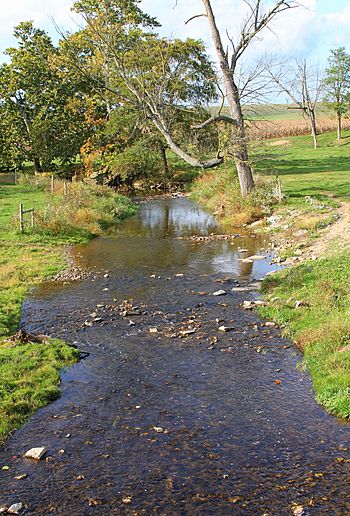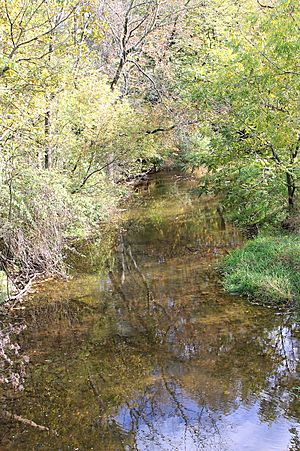Little Buffalo Creek facts for kids
Quick facts for kids Little Buffalo Creek |
|
|---|---|

Little Buffalo Creek looking upstream
|
|
| Physical characteristics | |
| Main source | base of a mountain in White Deer Township, Union County, Pennsylvania, United States between 800 and 820 feet (240 and 250 m) |
| River mouth | Buffalo Creek in Kelly Township, Union County, Pennsylvania, United States 456 ft (139 m) 40°59′09″N 76°55′41″W / 40.98589°N 76.92797°W |
| Length | 10 mi (16 km) |
| Basin features | |
| Progression | Buffalo Creek → West Branch Susquehanna River → Susquehanna River → Chesapeake Bay |
| Basin size | 19.0 sq mi (49 km2) |
Little Buffalo Creek is a stream in Union County, Pennsylvania. It's about 10 miles (16 km) long. This creek flows through White Deer Township and Kelly Township. It eventually joins Buffalo Creek. The land area that drains into Little Buffalo Creek is called its watershed. This watershed covers about 19 square miles (49 km²).
The creek's water quality is affected by things like extra nutrients and dirt. It can also have bacteria like E. coli and warmer water. Many parts of the watershed are covered by forests or farms. People have built many bridges over the creek. Efforts are being made to keep the creek healthy. For example, a grant helped farmers use better practices to protect the water. The creek is also home to wild trout and American eels.
Contents
Where Does Little Buffalo Creek Flow?
Little Buffalo Creek starts at the bottom of a mountain in White Deer Township. It flows south for a bit. Then, it turns to flow east-northeast and then east-southeast. After a while, it turns east-northeast again for a few miles. It then heads south-southeast and enters a valley.
The creek continues its journey, turning south and entering Kelly Township. It flows south for some distance. Then, it meanders east for a short stretch. The creek turns south again before finally turning southwest. It then flows south-southeast, then east-northeast, and finally southwest. After this winding path, it meets up with Buffalo Creek. Little Buffalo Creek joins Buffalo Creek about 3.3 miles (5.3 km) before Buffalo Creek reaches its own mouth.
Water Quality and Health
The water in Little Buffalo Creek is affected by several things. These include extra nutrients, too much sediment (dirt), and bacteria like E. coli. The water temperature can also be warmer than ideal.
How Water Quality Changes
In 2000, a lot of sediment was carried by the creek. This was about 2.5 million pounds (1.1 million kg) of dirt. By 2008, this amount had slightly decreased. A big part of this sediment comes from streambank erosion. This is when the soil along the creek banks washes away. Farm fields, especially those with row crops, also add a lot of sediment. Experts believe that with better practices, the amount of sediment could be greatly reduced in the future.
Nutrients like nitrogen and phosphorus are also found in the creek. These can come from farms or other sources. High levels of these nutrients can harm the creek's ecosystem. Just like with sediment, there are plans to reduce these nutrient levels.
Protecting the Creek
The creek's watershed has some areas that are prone to floods. This means that during heavy rains, the creek can overflow its banks. This can make it hard for people to get around. To help protect the creek, some landowners have created wetlands. These wetlands act like natural filters for the water. They also provide homes for waterfowl. Farmers have also planted riparian buffers along the creek. These are strips of trees and plants that help filter runoff before it enters the water.
Land Around the Creek
The land that drains into Little Buffalo Creek covers about 19 square miles (49 km²). This area is mostly in the northeastern part of the larger Buffalo Creek watershed.
There are about 38.7 miles (62.3 km) of streams in the watershed. About 14.6 miles (23.5 km) of these streams flow through farm fields. The upper parts of the watershed have more forests. The lower parts, closer to where the creek joins Buffalo Creek, have more farms.
Most of the land in the watershed is forested, making up 54 percent. Another 37 percent is used for agriculture. Only a small part, about 3 percent, is covered by hard surfaces like roads or buildings. However, this could increase in the future. The agricultural land includes fields for row crops and areas for hay and pastures. There are also small areas with commercial buildings and homes.
Bridges and History
Little Buffalo Creek has been an important part of the area's history. Its name was officially recorded in 1979.
Long ago, in the winter of 1774 to 1775, a gristmill (for grinding grain) and a sawmill were built on the creek. These mills were very important for the early settlers. One old bridge, called the Hubbler Bridge, was used to transport grain to Campbell's Mill.
Many bridges have been built over Little Buffalo Creek over the years. Some of the older bridges were built in the 1930s and 1940s. For example, a bridge carrying State Route 1003 was built in 1934. Another bridge on State Route 1004 was built in Kelly Cross Roads in 1950. These bridges help people travel across the creek.
In 2014, a large grant of $329,851 was given to the Union County Conservation District. This money was used to help farmers in the creek's watershed use better practices. These practices help protect the creek's water quality.
Animals and Plants
The area around Little Buffalo Creek is special for wildlife. It's known as a Coldwater Fishery and a Migratory Fishery. This means it's a good place for fish that like cold water. It's also a stop for fish that travel long distances.
Wild trout naturally reproduce in a section of the creek. This part is about 1.99 miles (3.20 km) long. In the 1920s, people even saw white suckers spawning in the creek.
In 2013, a group of American eels were released into Little Buffalo Creek. These eels also carried the tiny young of freshwater mussels. The goal of this project was to bring back American eels and freshwater mussels to the ecosystem of the Susquehanna River. This helps the whole river system stay healthy.
A study in 2008 found that Little Buffalo Creek was healthier than expected. This was good news, especially since there's a lot of farming and livestock in the area. Landowners have also created wetlands along the creek. These wetlands provide homes for waterfowl like ducks and geese. Also, programs have helped farmers plant riparian buffers along the creek. These plant strips help filter the water and protect the creek's banks.


